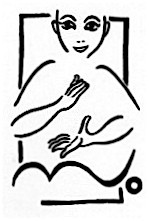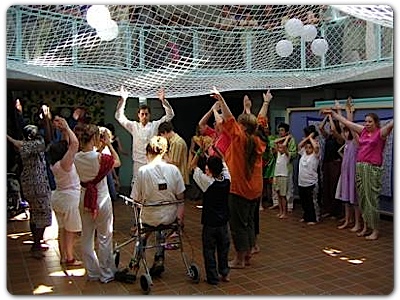|
 About the hands-on concept underlying the Vaitari book About the hands-on concept underlying the Vaitari book  Each page contains a picture relating to the artistic traditions and customs of Kerala together with a short series of syllables indicating the sounds associated with them. As the Malayalam word "vaitari" in the title of the book indicates, the pictures relate to familiar "sound patterns that can be produced with one's voice" straight from the page. Sound recordings supplied on the accompanying audio-CD demonstrate how these sounds are commonly produced in Kerala. But this book is not primarily about learning how to precisely reproduce sounds made by others or training to become a performer oneself: It goes without saying that this task must be left to qualified teachers and requires a far longer period of time than that available in the typical classroom situation for which this book has been created. What this book is really about is the sharing of the hands-on lessons that Kerala's performing arts offer even to beginners with the help of vaitari-syllables and simple hand gestures. These gestures were originally developed by John Curwen (1816-1880) and soon evolved into an internationally acclaimed learning method. Today it is also known as the Kodály method due to the success of the music education system introduced by the great Hungarian educationist and composer Zoltan Kodály (1882 - 1967). Each page contains a picture relating to the artistic traditions and customs of Kerala together with a short series of syllables indicating the sounds associated with them. As the Malayalam word "vaitari" in the title of the book indicates, the pictures relate to familiar "sound patterns that can be produced with one's voice" straight from the page. Sound recordings supplied on the accompanying audio-CD demonstrate how these sounds are commonly produced in Kerala. But this book is not primarily about learning how to precisely reproduce sounds made by others or training to become a performer oneself: It goes without saying that this task must be left to qualified teachers and requires a far longer period of time than that available in the typical classroom situation for which this book has been created. What this book is really about is the sharing of the hands-on lessons that Kerala's performing arts offer even to beginners with the help of vaitari-syllables and simple hand gestures. These gestures were originally developed by John Curwen (1816-1880) and soon evolved into an internationally acclaimed learning method. Today it is also known as the Kodály method due to the success of the music education system introduced by the great Hungarian educationist and composer Zoltan Kodály (1882 - 1967).
Vaitari includes, among other things, jubilant expressions uttered by family members and friends during a marriage (fantasy icons on page 8) or by the cheering crowds during a boat race (front cover page). Harvest songs (back cover page) also fall into this category. The beauty is that children's poetry and nursery rhymes in all cultures contain elements also found in Kerala's vaitari, just as the technical syllables (jati) used for notating, practicing and remembering dance movements (adavus) or drum strokes (Tamil "solkattu"). The word vaitari thus denotes a characteristic approach to learning and remembering involving body along with all the senses, emotional appeal and imagination. Hence the artist's visual references to all these arts, customs, mythology and folklore. The famous peace mantram (page 15) completes the picture.
The use of the hand gestures in learning singing seen on page 16 brings together the customary dance gestures (mudras or hastas) seen in Kerala's graceful Mohiniyattam dance (centre spread) and the century-old European tradition of teaching singing. The inclusion of this ingenious method, adapted in accordance with the gestures presently taught in the teachers' training programme of the Bern University of the Arts, is based on the experience that singing is often accompanied by initial bad postures on the part of learners that inhibit proper breathing and thereby free vocal expression. Using these gestures on the basis of the book's illustrations helps learners to free themselves from their physical and mental inhibitions and approach the singing of any series of notes from which an Indian raga can be formed either with the help of a recording or in the presence of an experienced Indian teacher.
 Being designed for modern children and youngsters as well as their educators, the authors have brought in their respective experiences from different fields and arts to make the book an intercultural as well as an interdisciplinary experience. In other words, different people are bound to make different use of it, whether or not they follow the arrangement of the book's pages. There is, of course, a plan underlying the arrangement which should make a difference to educators seeking to make good use of that one "window in time" during which they can freely interact with those entrusted to them, including those with special needs, with the help of ideas from India. Being designed for modern children and youngsters as well as their educators, the authors have brought in their respective experiences from different fields and arts to make the book an intercultural as well as an interdisciplinary experience. In other words, different people are bound to make different use of it, whether or not they follow the arrangement of the book's pages. There is, of course, a plan underlying the arrangement which should make a difference to educators seeking to make good use of that one "window in time" during which they can freely interact with those entrusted to them, including those with special needs, with the help of ideas from India.
Finally, a word about the didactic concept that teachers may profit from with the help of this publication: It is no news for an experienced educator to read that it is their innate curiosity that makes children concentrate and cooperate in a classroom. The artwork created for this book is designed to kindle their sense of wonder in order to get involved, become creative and, where time and environment permit, resort to peer teaching. In this sense it is indebted to Dr. Maria Montessori's method for teaching young children to become self-confident personalities valuing achievement as much as empathy. Her learning psychology and teaching ethics, which has gained an enormous following the world over and evolved over a period of over a century and even reached the true elite of the Indian subcontinent.
Three phases of involvement  Without going into the details of the valuable Montessori method on which so much has been written by qualified pedagogues, let us consider three phases of involvement wherein our modest picture book can play a key role without much preparation or cost: (1) Starting from concentration based on the experience of wonder ("adbhuta" in Indian art theory), it becomes possible to become directly active by way of repeating the vaitari syllables accompanying the pictures seen on each page; (2) leaving one's inhibitions and fear of failure by experimenting with these syllables in a playful manner, exploring their "colours" and "textures" and asking how they might relate to the main subject of each picture, cooperation becomes possible in a lighthearted manner; (3) playful engagement with a particular page facilitates memorization as it takes away the monotony of conventional learning; young children in particular will delight in exploring some of the sound combinations by repeating and re-arranging them which, incidentally, is also the key to the learning of India's sacred Veda scriptures that have been faithfully handed down for thousands of years. Here it is worth recalling that the findings of modern brain science confirm that memory is based on a vast array of "synaptic junctions", expanded and maintained with the help of countless associations, movements, emotional responses, repetitions and permutations rather than in a straightforward manner in order to be lasting. Although the plan of the inside pages of the present book are broadly arranged on the lines of "Concentration - Cooperation - Memory" in that sequence, any particular page including the front and back cover pages could serve as starting point for a personalized route taken for one's personal journey through Kerala's vast and varied cultural landscape! Without going into the details of the valuable Montessori method on which so much has been written by qualified pedagogues, let us consider three phases of involvement wherein our modest picture book can play a key role without much preparation or cost: (1) Starting from concentration based on the experience of wonder ("adbhuta" in Indian art theory), it becomes possible to become directly active by way of repeating the vaitari syllables accompanying the pictures seen on each page; (2) leaving one's inhibitions and fear of failure by experimenting with these syllables in a playful manner, exploring their "colours" and "textures" and asking how they might relate to the main subject of each picture, cooperation becomes possible in a lighthearted manner; (3) playful engagement with a particular page facilitates memorization as it takes away the monotony of conventional learning; young children in particular will delight in exploring some of the sound combinations by repeating and re-arranging them which, incidentally, is also the key to the learning of India's sacred Veda scriptures that have been faithfully handed down for thousands of years. Here it is worth recalling that the findings of modern brain science confirm that memory is based on a vast array of "synaptic junctions", expanded and maintained with the help of countless associations, movements, emotional responses, repetitions and permutations rather than in a straightforward manner in order to be lasting. Although the plan of the inside pages of the present book are broadly arranged on the lines of "Concentration - Cooperation - Memory" in that sequence, any particular page including the front and back cover pages could serve as starting point for a personalized route taken for one's personal journey through Kerala's vast and varied cultural landscape!
All rights reserved © 2020 | Art © Arun V.C.
|
|

 Being designed for modern children and youngsters as well as their educators, the authors have brought in their respective experiences from different fields and arts to make the book an intercultural as well as an interdisciplinary experience. In other words, different people are bound to make different use of it, whether or not they follow the arrangement of the book's pages. There is, of course, a plan underlying the arrangement which should make a difference to educators seeking to make good use of that one "window in time" during which they can freely interact with those entrusted to them, including those with special needs, with the help of ideas from India.
Being designed for modern children and youngsters as well as their educators, the authors have brought in their respective experiences from different fields and arts to make the book an intercultural as well as an interdisciplinary experience. In other words, different people are bound to make different use of it, whether or not they follow the arrangement of the book's pages. There is, of course, a plan underlying the arrangement which should make a difference to educators seeking to make good use of that one "window in time" during which they can freely interact with those entrusted to them, including those with special needs, with the help of ideas from India.